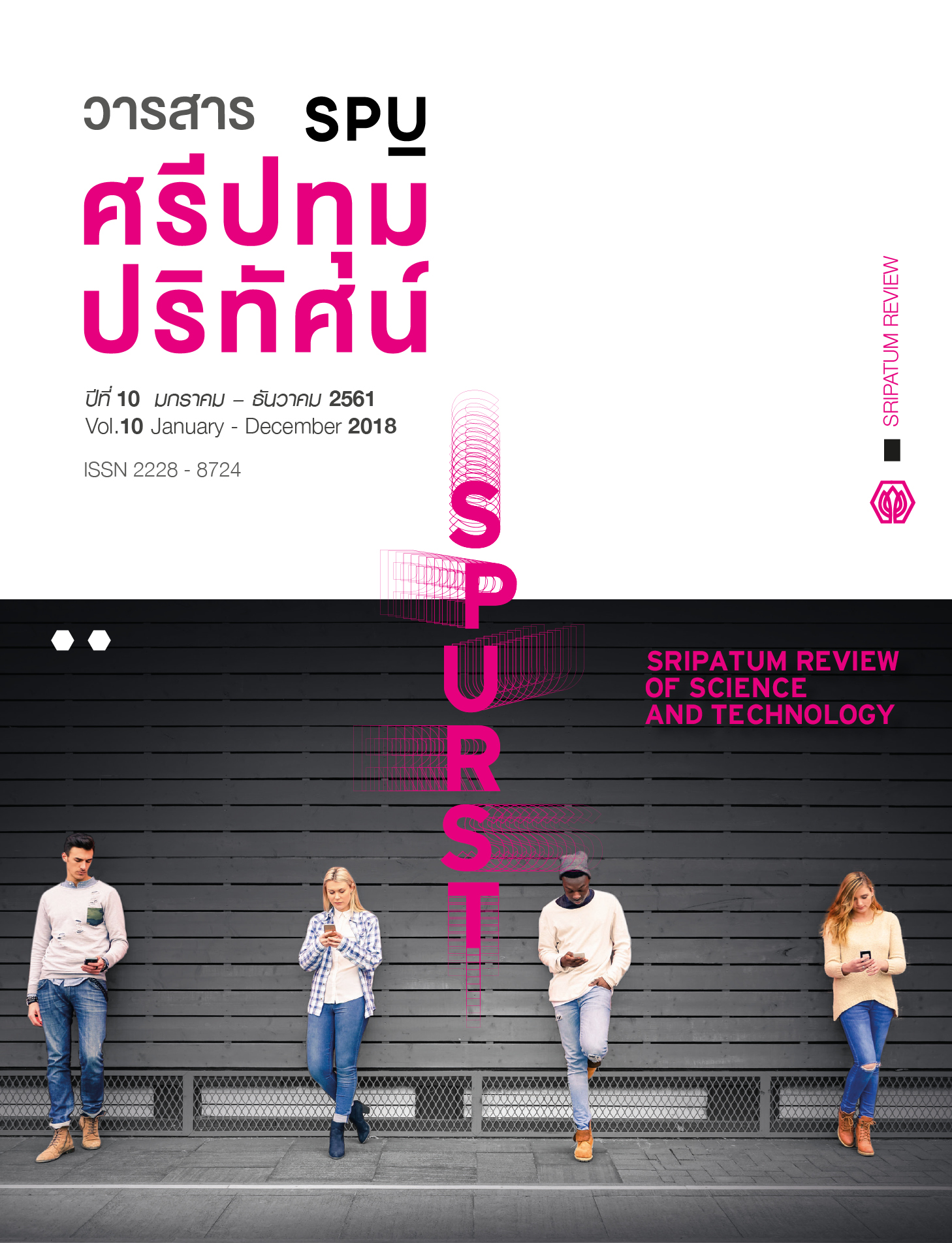การประเมินประสิทธิภาพการใช้งานรถยนต์เช่า กรณีที่ตัวแบบมีปัจจัยไม่พึงประสงค์ ด้วยวิธีการวิเคราะห์เชิงล้อมกรอบข้อมูล(DEA)
Main Article Content
บทคัดย่อ
การวิจัยนี้มีวัตถุประสงค์เพื่อศึกษาและเปรียบเทียบวิธีการประเมินประสิทธิภาพการใช้งานรถยนต์เช่า กรณีที่ตัวแบบมีปัจจัยไม่พึงประสงค์ ด้วยวิธีการวิเคราะห์เชิงล้อมกรอบข้อมูล (DEA) โดยศึกษาการ
ใช้งานรถยนต์เช่าของหน่วยงานราชการแห่งหนึ่งจำนวน 22 หน่วยตัดสินใจ โดยมีข้อมูลค่าเช่ารถยนต์ เป็นปัจจัยนำเข้า ระยะทางที่ใช้งานทั้งหมดและค่าใช้จ่ายในการซ่อมบำรุง เป็นผลลัพธ์พึงประสงค์ และค่าใช้จ่ายในการซ่อมจากอุบัติเหตุ เป็นผลลัพธ์ไม่พึงประสงค์ จากระบบสารสนเทศของหน่วยงานและบริษัทที่ให้เช่ารถยนต์ ด้วยการวิเคราะห์ DEA กรณีมีปัจจัยไม่พึงประสงค์ ในตัวแบบการวิเคราะห์ 3 วิธีที่แตกต่าง ได้แก่ วิธีผลคูณผกผัน วิธีการปรับปัจจัยผลลัพธ์ไม่พึงประสงค์เป็นปัจจัยนำเข้า และวิธีผลบวกผกผัน โดยเปรียบเทียบค่าเฉลี่ยของคะแนนประสิทธิภาพด้วยการวิเคราะห์ความแปรปรวน ผลการวิจัยพบว่าตัวแบบการวิเคราะห์ทั้งสามวิธีสามารถประเมินประสิทธิภาพได้ผลใกล้เคียงกัน และนำค่าเฉลี่ยของคะแนนประสิทธิภาพไปทดสอบด้วยวิธีการทางสถิติ พบว่าทั้งสามวิธีไม่มีความแตกต่างกัน ที่ระดับนัยสำคัญทางสถิติ 0.05 สรุปได้ว่าการประเมินประสิทธิภาพ ด้วยการวิเคราะห์ DEA กรณีตัวแบบมีปัจจัยไม่พึงประสงค์ สามารถเลือกใช้ตัวแบบการวิเคราะห์วิธีใดวิธีหนึ่ง อย่างไรก็ตามควรมีการพิจารณาสถานการณ์และข้อมูลของปัจจัยเกี่ยวข้องที่อาจแตกต่างกันในแต่ละหน่วยงาน
Article Details
เอกสารอ้างอิง
Azadi, M., Shabani, A., Khodakarami, M., and Saen, R. F. (2014). Planning in feasible region bytwo-stage target-setting DEA methods: An application in green supply chain management of public transportation service providers. Transportation Research Part E: Logistics and Transportation Review, 70, 324-338.
Balezentis, A. and Balezentis, T. (2011). Assessing the efficiency of Lithuanian Transport sector by applying the methods of multimoora and data envelopment analysis. Transport, 26(3), 263-270.
Berg, S.A., Forsund, F.R., and Jansen, E.S. (1992). Malmquist indices of productivity growth during the deregulation of Norwegian Banking 1980-89. The Scandinavian Journal of Economics, 94, 211-228.
Bian, Y., Hu, M., and Xu, H. (2015). Measuring efficiencies of parallel systems with shared inputs/ outputs using data envelopment analysis. Kybernetes, 44(3), 336-352.
Bowlin, W. F. (1987). Evaluation the efficiency of US Air-Force real property maintenance activities. The Journal of the Operational Research Society, 38(2), 127-135.
Charnes, A., Clark, C. T., Cooper, W. W., and Golany, B. (1984). A developmental study of Data Envelopment Analysis in measuring the efficiency of maintenance units in the U.S. Air Forces. Annals of Operations Research, 2(1), 95-112.
Charnes, A., Cooper, W. W., Lewin, A. Y., and Seiford, L. M. (1994). Basic SEA Models. In Data Envelopment Analysis Theory, Methodology and Applications, pp. 23-47. Dordrecht: Springer.
Charnes, A., Cooper, W.W and Rhodes, E. (1978). Measurement the efficiency of decision making units. European Journal of Operational Research, 2, 429-444.
Cook, D. W. (2006). Qualitative Data in Dea. Handbook on Data Envelopment Analysis , 153-175. Boston, MA.: Springer.
Daraio, C., Diana, M., Costa, F. D., Leporelli, C., Matteucci, G., and Nastasi, A. (2016). Efficiency and effectiveness in the urban public transport sector: A critical review with directions for future research. European Journal of Operational Research, 248(1), 1–20.
Djordjevic, B., Krmac, E., and Mlinaric, T. J. (2018). Non-radial DEA model: A new approach to evaluation of safety at railway level crossings. Safety Science, 103, 234-246.
Farrell, M. J. (1957). The Measurement of Productive Efficiency. Journal of the Royal Statistical Society. Series A (General), 120(30), 253-278.
Golany, B. and Roll, Y. (1989). An application Procedure for DEA. Omega: The International Journal of Management Science, 17, 237-250.
Jiang, G., Liu, L., and Lv, H. (2017). Transportation system evaluation model based on DEA. Journal of Discrete Mathematical Sciences and Cryptography, 20(1), 115-124.
Koopmans, T. C. (1951). Activity Analysis of Production and Allocation. New York: Wiley.
Krai-u., M. (2009). Satisfaction of passengers on using air-conditioned van service.
Case Study: Bangkok - Phetchaburi (Line 73). Master of Business Administration, Bangkok University. (in Thai)
Liu, W. and Sharp, J. (1999). DEA models via goal programming. In Data Envelopment Analysis in the Service Sector, 79-101. Wiesbaden: Deutscher Universitätsverlag.
Lovell, C.A.K., Pastor, J.T. and Turner, J.A. (1995). Measuring macroeconomic performance in the OECD: A comparison of European and non-European countries. European Journal of Operational Research, 87, 507-518.
Ministry of Finance. (2012). Ministry of Finance Report Urgent GK 0406.4/v.64 Rental rates for government cars, 1-3. (in Thai)
Nimmalairat., C. (2011). The technology Efficiency of Refinery in Thailand. Master of Economic, Srinakharinwiroj University. (in Thai)
Pal, D., and Mitra, S. K. (2016). An Application of the directional distance function with the number of accidents as an undesirable output to measure the technical efficiency of state road transport in India. Transportation Research Part A: Policy and Practice, 93, 1-12.
Pina, V., and Torres, L. (2006). Public–private efficiency in the delivery of services of general economic interest: The case of urban transport. Local Government Studies, 32(2), 177 – 198.
Royston, J.P. (1983). Some techniques for assessing multivariate normality based on the
Shapiro-Wilk W. Applied Statistics, 32, 121-133.
Sanonil., S. (2016). Car Rental Behavior of Foreign Tourists in Pattaya. Master of Business Administration, Burapha University. (in Thai)
Scheel, H. (2001).Undesirable outputs in efficiency valuations. European Journal of Operational Research, 132(2), 400-410.
Seiford, L. M. and Zhu, J. (2002). Modeling Undesirable factors in efficiency evaluation. European Journal of Operational Research, 142, 16-20.
Sharma, M. G., Debnath, R. M., Oloruntoba, R., and Sharma, S. M. (2016). Benchmarking of rail transport service performance through DEA for Indian railways. The International Journal of Logistics Management, 27(3), 629-649.
Tone, K. (2001). A slacks-based measure of efficiency in data envelopment analysis. European Journal of Operational Research, 130(3), 498-509.
Wojcik, V., Dyckhoff, H. and Gutgesesell, S. (2017). The desirable Input of Undesirable Factors in Data Envelopment Analysis. Annals of Operation Research, 259(1-2), 461-484.
Wu, J., Zhu, Q., Chu, J., Liu, H., and Liang, L. (2016). Measuring energy and environmental efficiency of transportation systems in China based on a parallel DEA approach. Transportation Research Part D: Transport and Environment, 48, 460-472.
Zhou, P., and Ang, B. W. (2008). Linear programming models for measuring economy-wide energy efficiency performance. Energy Policy, 36(8), 2911–2916.


